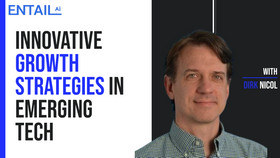Authenticity, trust, and connection: Lora Osborn's marketing musts for 2026
Explore how connecting with customers on a deeper level should be front and center in your marketing strategy.
Updated February 28, 2024
Marketing teams are faced with a range of uncertainties. With economic challenges and budget cuts abound, we have to make every dollar count.
So how should marketers adjust their strategies in this climate? Which tactics will provide the best ROI? What creative approaches can help brands stand out?
I had a great time talking to Lora Osborn, Senior Director of Marketing at Sentera, about these concerns as well as the increased focus on profitability and more general marketing strategies for 2026.
We also discussed:
- Account-based marketing
- Creating content for social media
- Branding strategies
- AI's effect on content creation
- Putting video first
I think Lora brings up many interesting points—especially around generative AI and building trust and topical authority. Let's take a look.
Welcome to the Entail podcast, where we host and interview marketing leaders from different companies, often SaaS or e-commerce companies. Today, I have the pleasure of having Laura Osborne, Senior Director of Marketing at Sentera. Hi, Laura. How are you doing?
Great, thanks for having me.
It's great to have you here from cold Minnesota.
Yeah. We're trying to stay warm.
Before we start, maybe you want to take a minute to introduce yourself and talk a bit about your experience.
I've been in the marketing world for about 20 years. I always say the first half of my career was spent in public relations and marketing communications. Then, about 10 years ago, I made a switch into product marketing and corporate marketing in the SaaS world, focused on market positioning, sales enablement, and the traditional marketing flow around lead generation, conversion, making sure that we're taking marketing leads and closing them as opportunities to drive revenue for the company.
Recent shifts in the marketing landscape
Sounds very cool. I wanted to talk to you about the marketing trends we see in 2026. There's a lot of talk around AI and changes happening in the marketing world. You can see companies letting people go because of cutbacks. We see this with our clients and prospects because Entail is a self-marketing platform. A lot of companies are cutting back on their marketing expense, letting people go, and thinking long and hard before investing in different channels.
It seems like a couple of years ago, when money was cheap and companies were flush with money, they weren't really critical of their acquisition costs and spending much more on marketing. Now that's definitely changed. So maybe let's start with how you see the landscape in that sense.
Yeah, I think we started to see the landscape shift towards the end of last year. There were over 600 tech companies that had done layoffs. Not all impacted marketing, but already this year, I think I saw a stat last week that there were 47 tech companies that had done layoffs. Layoffs are definitely a big component of what's happening, and marketing teams are part of those impacted. As you said, the resources are not what they used to be. I think a huge driver behind that is tech companies are really starting to focus more on how they can be profitable.
Over the past decade or so, it's been more about revenue generation, not worrying about profitability or the bottom line because if we can just say we're bringing in that money, we're going to look good to our investors.
Before, it was about doing roadshows and taking as much funding as we could to bring in new customers. Marketing teams will have to be more cognizant of the actual cost of acquisition and what channels are actually going to drive people in.
Yeah, it's definitely a trend we've seen more with clients, even smaller startups that have shut down. I saw a few companies in the Shopify app space that were very excited to develop new tools for Shopify. Then everyone realized there are about 2 million Shopify stores, but only a few hundred thousand are really successful. It's not a very big market, and there's a lot of apps and tools chasing that software.
As the market shifted, I saw acquisition costs for some clients in that space went through the roof. It used to be around a hundred dollars per customer, and it went up to about 500, a five-fold increase, completely ruining their business model. A few of them went out of business because of that. That's already like one place where you see this change in the economy affecting companies. For others, more mature ones that can withstand this change, they cut down on marketing and started making sure their marketing is more effective, not just spending money without ROI.
But first of all, do you think this affects SaaS companies more than e-commerce companies, or does it affect everyone across the board?
I think e-commerce is probably facing a bit of a different challenge, with inflation and market dynamics leading consumers to tighten their purse strings.
So, e-commerce needs to respond to that. Considering the apps you can use with Shopify, a lot of people are looking at what they can get by with for free. Maybe it's not the Cadillac but just the Chevy; it gets them where they need to go without all the bells and whistles. I think that's how people are starting to look at things.
Talking about ROI is so important from a SaaS perspective. About a decade ago, working with a SaaS company, our cost per lead was about $6. I remember we reported to the chief revenue officer. He thought that was crazy, too high. We had to figure out how to drive that down. Recently, looking at $700-$800 for cost per lead was okay. But I think we're going to start to see a shift back to cheaper channels for bringing in leads and qualifying them faster, so we're not spending all that additional capital, especially with the uncertain investor landscape ahead.
That's also very interesting, especially in e-commerce where people are spending less. They're the beginning of the chain. I definitely see companies spending less on Meta now, with the economy changing and privacy regulations, like the cookie-less world, making targeting on Facebook much more difficult. So companies are spending less there and looking for alternatives, including investing in influencers. But what do you think about different channels? Where are companies turning to now if they're moving away from spending so much on Meta or Facebook, like before?
Yeah, I think one shift I'm starting to see is a bigger focus on organic search, so where you can get wins from SEO. It's always been important because if someone's searching for something in your industry, you want to come up.
With those privacy regulations, it's making it hard to justify spending those dollars on Meta or the dollars on LinkedIn, when you know that you might hit a fraction of who you were targeting before.
We're likely to see more of this shift. Also, account-based marketing has seen a big shift over the past five years, with every organization now using a tool to support this. Doing this in different ways is going to make it more productive, especially as we look at the cost per lead because those programs tend to be really expensive.
But looking at how you can partner with sales to ensure that you're driving account-based outreach without needing fancy swag packs or virtual parties. What can you do to still give that account or those contacts the right attention and make sure they understand your value proposition, while serving them in the right way without spending all your resources?
Understanding account-based marketing
That's very intriguing to me. Maybe you can elaborate a bit about the account-based marketing techniques. Do you refer to SDR activities, like reaching out to people on LinkedIn or through email? What type of activities are you speaking about?
Yeah, in recent years, there's been a shift towards gifting, swag, or hosting special events for strategic accounts. For example, hosting a virtual wine tasting for our top eight accounts to see who we can engage over the phone and who will join us and let's start to build that relationship. This approach has been a good way to return to traditional marketing's one-on-one interactions that have been lost in many of the digital channels and mass media we've turned to in the past 15 years.
But I think what people are realizing is that having one-to-one conversations and the ability to get in front of them, wow them, and give them the VIP treatment works. It gets people excited about what we're doing. We can have that conversation with them, but they're also looking at their budgets and realizing while it's effective, it's consuming the majority of the budget. There needs to be a happy medium.
SDRs are fantastic for starting that conversation. Generally, they're not ready to go from A to Z in that initial conversation. So, it's about looking at other methods, like involving industry specialists on the phone to provide that VIP experience without breaking your marketing budget.
Yeah, it seems, on one hand, there's all this talk about advancements in AI, ChatGPT this and that, but when you really speak with real marketing leaders, there's a significant shift in the other direction—going back to basics, to authentic human connections, to being real in a way and away from just the ChatGPT type of marketing.
Despite the get-rich-quick schemes you see around ChatGPT marketing or AI marketing on platforms like Google, TikTok, or YouTube, my experience, discussions with clients, and even arguments have shown that while content creation with AI has become easier—not just written content but also effects and video editing capabilities like CapCut for cool videos on TikTok—it brings a challenge. Many companies get pressured by executives to drive down marketing costs using AI, leading them to adopt tools that reduce costs. This results in content that's very much like what someone without a budget could create. For a serious company, why would it make sense to create content with the same means as someone without a budget?
On the other hand, the content you're creating with these tools is very superficial. So, if everyone can create that content, where's the value? In marketing, the goal is to be different and stand out, but that's really not what you're doing. That's why we've shifted in the other direction, which is very similar to what you're saying about the human connection, creating content experts to really bring out the human experience, the unique perspectives, experience, and expertise people have. Because that's what other people mostly find interesting.
Solving the challenge of creating social media content
It seems this shift in account-based marketing is very similar. And then you're also talking about search and content. There's a big shift there as well because of all the changes that are coming within Google, even though they're still rolling out their Search Generative Experience. It's not open in all countries, and you need to opt in if you want to have that experience. You can see that this experience is incomplete. There's a good reason why they haven't rolled it out to everyone, right? It's not released to the entire population. It's just an experiment. So, even there, organic search is going to change. Together with that, you see the world's attention is on social media. So, that leads me to think—like you're saying—a lot of people are going back to authentic content, but they also need to go and invest more in social media. In the organic side of social media, not just paid, right?
Right. Starting to build those audiences will be so important because, as consumers, we've been trained, "Okay, I found this company. It sounds really cool. Let me see what their footprint looks like." Because there are so many opportunities where it might not be the company that was represented, but I think having that organic social will be really important. From a budget-conscious marketer, it's giving you some free impressions and free outreach within the market.
I really like the term "footprint" you mentioned. When I look at websites in the account-based marketing type work, I want to look at a company and see if they're a good fit for Entail. I would look at their website, their traffic on SEMrush, and their social accounts to look at their footprint. I've never used this term, but it's the exact term for this.
So you want to look for their footprint because usually a good business will have a significant social media footprint. However, while social media impressions are "free," creating content requires time and budget. It's also a big challenge for companies. How do you think companies can overcome that?
Going back to ChatGPT, I think it does have its place, but you get what you pay for. So using ChatGPT to write your next five blog posts, what you're going to get is basically what you paid for. You're going to get something regurgitated back. It won't hit the mark for what your target market is looking for. However, ChatGPT can be powerful for defining topics to consider. Then, you can use your expertise and content strategists to help build those out.
As resources become tighter, it's important to think about where you're spending your budget. It's about where you can get the biggest bang, and that's content. Because whenever you're doing demand generation, account-based marketing, organic social, or third-party advertisements, what are you going to say? And if you don't have the content to feed that, those campaigns aren't going to be successful. As you think about the content that you need, it's not regurgitating what your company does; it's not the value props for your products.
And as we see this shift, it's about figuring out how AI, ChatGPT, and similar tools can work for you. They're likely best at helping to define topics, list the top strategic accounts to target in a new segment, or come up with content nuggets. Then, it's crucial to have the right people to flesh those out, making the content appealing to your target audience rather than just using flowery language and broad topics that ChatGPT excels at.
I agree, and I also agree with the content needing to be informational, educational, and interesting. I often say that's the currency you have as a brand. You're not Netflix; you're not creating entertainment. You can be entertaining as well, but that's not your main goal. Unless you're a fashion brand showing models or a sports brand showing athletes, usually as a brand, you want to inform your audience. And it works well for brands that sell products where people really need information as part of their buying process.
» More from the podcast: Listen to Ari Yablok break down branding's impact.
Creating content to establish brand identity
What do you think in terms of branding and positioning for companies? What do you think the best methods are? Do you think it's really mostly about content? Or what other techniques would you use to establish that brand identity?
I think content is really important because, as you mentioned, it's how you create that content personality, showing who we are. Whether we aim to be educational or address a busy marketing leader who doesn't have a lot of time to read deep guides and that sort of thing, if you have the right topic, you're able to get them interested. So, they're going to click, and they're going to read. I do think content is going to be a really important piece of that.
I also think earned media, through media relations and getting placements in third-party publications, broadcasts, or podcasts, will continue to be important for building brand identity. We're seeing a shift back to consumers seeking ways to validate trust with organizations. At the end of the day, we're selling to people, even in B2B where we're selling technology to leaders in SaaS. But they're still people, and the want to validate and make sure if something is legitimate and real. Earned media provides that validation from a third party, often at a much lower cost than paid advertorials or advertisements. So, we're likely to see a shift in that direction. So just a different form of content, but at the end of the day, we're going to see that content will continue to be the cornerstone of what marketing teams need to make their strategies come to life this year.
Yeah, it's really interesting. It makes a lot of sense what you're saying. It's just funny that, in the world of ChatGPT, where content should have been and almost not interesting anymore, it's become the most interesting thing and one of the most interesting things to nail, to get it right, to get the right content that's interesting and not just fluff or regurgitated content from ChatGPT.
You also mentioned trust, which I want to touch on a little bit later because I think it's one of the key things now in the age of AI and misinformation.
Leveraging earned media
But I'm curious to learn more about earned media since I don't have much experience with it. So you mean using your content and publishing it on publishers and large websites? Can you expand on that a little bit?
As we look at B2B SaaS, everyone is part of an industry niche. It involves identifying trade publications where decision-makers seek information for their roles and finding ways for your content to be published as a byline or having an internal spokesperson who can address specific topics. But finding ways that content can live elsewhere instead of just on your website.
From an SEO and search perspective, this helps with building out your footprint. This took a backseat in the last five to seven years, but we're beginning to see a resurgence as people recognize the value that creates. Because it's that third-party validation of, "Hey, this is a topic that ABC company has come up with, but this well-respected industry publication, they're also talking about it. So this company is on the right track." So being able to align yourself in that way, I think is going to be really powerful.
So it's a lot of basically PR to get that recognition.
Yeah. We've seen that shift quite a bit from pushing out a press release to seeing who we can get to talk about what we're talking about from a product perspective. I think there's just a little bit more authenticity that can come with having that be a solid part of your marketing strategy overall.
Also probably activities like creating content for publications relevant to your company. For us, it would be like Search Engine Journal. Those types of publications. Just creating content there because that's where some of our audience hangs out. That's where they go for information.
Right, yeah.
Building brand trust
Okay, that's definitely an interesting technique. I want to go back to trust, which I think is a major issue. With everything becoming so easy, it's also very easy to mislead people and create fake information. I think trust will be the most important currency for businesses to establish authority and trust in 2026 and beyond. I'd like to hear from you about the techniques you'd use to build trust.
I think from a marketing perspective, for some marketers, this is part of their day-to-day. For others, this is out of their wheelhouse, but it's getting on the phone with customers and with prospects. Understanding who they are and what are the things that keep them up at night.
This goes back to traditional product marketing of trying to understand who your ideal customer profile is. But I think oftentimes, having those conversations falls to the bottom of the list for marketing professionals because you have so many other things that are going on. But I think having those conversations, that extends that trust because it makes that customer feel like, "Oh my gosh, you actually do care about me. You care about who I am as a person. You care about the challenges that I have with my business, and you're here to actually help me." Having that additional touch point, especially somebody who isn't trying to sell them and trying to upsell them to the next product or trying to get them to pay more money, customers value that.
That's how, as marketing professionals, we can help to build that trust, but it also gives us a lot of good insight into what's actually happening in the market. And so, as we look at our messaging, as we look at our content, as we look at our demand strategy, that is probably the easiest and cheapest way to get the insight and the market research that we need. And it's great for the customer too.
So I think finding ways to have more of those conversations, getting customers on the phone. I think there's always, a conversation of where NPS should live in the organization. Should it be something that customer success owns or should it be with support, or should it be with marketing? Marketing can fight to have that so that they're able to have those touch points with customers. They get that feedback of, "How are we doing?" in that customer response to that survey. You can use it as a touch point to go back to them.
We see that with a lot of companies today. Chewwy is one of those brands that we hear about a ton . They do so well because they interact with their customers. They know their customers. They send birthday cards for dogs. They do what they can to make their customers feel special.
That's how you build trust. I think that's how you build that authenticity. That's how you build a marketing program that stands out in a year where we're starting to see those resources constrained. We're starting to see a diluted marketplace with a ton of messages thanks to ChatGPT and a lot of AI tools. Going back to those basics will be so important.
What I take from what you're saying, and I agree with, is that if you want to be a trusted brand, content is a must. It's how people perceive you. That's how you project yourself into the world. Without showcasing your thoughts or expertise, it's hard to be trusted. Sharing your expertise is the only way for people to really perceive who you are. Sure, recommendations and badges from platforms like G2 are also an indicator, but they only go so far.
» More from the podcast: Sandra Stepan discusses influencer marketing and creating content on autopilot.
The importance of topical authority
That's also very interesting when you look at how Google and topical authority works. Because when we work with websites on creating content and SEO, it's very difficult to get websites to rank for competitive keywords and searches as long as they don't have authority. If they have authority, it's much easier.
You can see, for example, that Forbes Advisor competes for keywords like "best website builders," "best loans," "credit cards," "dating apps"—super competitive searches that people spend a lot of money on PPC for those keywords. And they rank very well because of Forbes' incredible authority. It's really about that topical authority. So, it's very interesting because the way you put it is pretty much how Google works in a way.
But on social media, that's a bit different, right? On social media, it depends on the platform. But how do you perceive it on social media? Is it more like a combination of authority, information, entertainment, and building followers? How is that different there?
Social media is such a boon. It's so tough because I think it depends again on that brand and the brand that you're trying to build. Some companies want to use social media as a way to engage and interact so people know that the brand exists. I think others use it as a way of saying, "I'm just going to push out my news, and I just want people to be able to come here, see all the cool things that we've done over the past couple of months." Then there's also that educational aspect.
As you think about your social media strategy, yes, you want to be active and engaging. But how are you going to be engaging? A lot depends on your brand and brand identity.
One of the things I've done is not make all of your social media channels the same. You're able to have a different voice on Facebook versus Twitter versus LinkedIn because you might have a different persona who's following you based on which channels they interact with. So there is that opportunity of maybe you have one be more casual and entertaining where one becomes more educational and informative—trying to build out that strategy. It's not copy and paste the same post across all of the networks that you have. It's trying to figure out what is the best mix and what does that look like? I think it really does come down to the brand.
It's also interesting because on social media, for example, I was looking for a baby stroller. I have a baby now, so we were looking for a baby stroller, and I was doing some research on what's the best stroller. We ended up buying Bugaboo; they have beautiful products. When you check there, they have multiple accounts on Instagram, for example, global, the U.S. and the U.K., depending on the country you're in.
Almost all of their content is moms pushing strollers; sometimes there are dads as well, but mostly moms pushing strollers and some cute babies with them. I would say that's mostly bottom-of-the-funnel content.
So for me, it's my only child now. I'm still learning. I had a lot of dogs before that. I love dogs, but that's my first human puppy. So there's still a lot for me to learn. I would expect from a brand like that to create also a lot of content on "when should my child start eating on their own," when they should start walking, standing, sitting up," whatever—all those topics that I need to be educated on, because I don't know yet.
But from what I see on social media, most of it's not true to everyone. There's also brands that really stand out. For Bagaboo, they have beautiful content. Their products look amazing. I ended up buying, so I was convinced, but again, a lot of their content is just about their products. It's not really about educating their audience.
Successful social media strategies
I don't know if it's because it's more like e-commerce, and you really want to show like how beautiful the product is. But still, I see billions of opportunities to educate parents. How would you distribute or how would you build your marketing strategy for social media where it comes to like brand content or bottom-of-the-funnel content versus like more educational content that's supposed to increase your reach and build an audience?
I think the ability to build the bottom-of-funnel content based on kind of the customer experience, so case studies and testimonials, we talk about those a lot in B2B SaaS. Taking those and being able to leverage those on social media and having that voice. That's where we've seen the biggest lift is on LinkedIn.
If we take that to Twitter, we're not seeing the same thing. So again, taking a look at the different channels. As you think about bottom-of-funnel content, there's a huge opportunity to bring in that customer voice once again and have them help tell that story. But, there's also that opportunity to demonstrate that expertise. There could be an opportunity for a stroller company to say, "Here are three things that you need to look at if you're shopping for a stroller," and call out their differentiators.
And for a B2B SaaS company, it's the same thing. What are the differentiators? Again, pulling in that product marketing language to understand how you can differentiate yourself from the competition. There are a couple of vendors that I spoke to a couple of months ago as I was evaluating some software for my Martech stack.
It was interesting because the sales rep knew how to insert a bash against one of their competitors. They made a line of, "Oh, this is something that we do, and if you work with one of our competitors, this is not functionality that they have. You have to call their customer success manager to get them to do any of this, but this is automated in our software tool."
Of course, I had a demo with that competitor the next day, and that was the first question that I asked. They said exactly what the competitor said, "Oh, you call customer success, and they can help you with that." So if there's a way where you can encapsulate that and put that on your social media, that's how you can start to get those buyers to think of your differentiators.
You want to do it in a way where you're not obviously bashing the competitor, but you want to make sure that you're being very clear about how you differentiate in the market. There's a way where you can finesse that and do that very well. That's when you're starting to build that bottom-of-funnel content where you can start to build that authority. You can have that authenticity, and then you can show, hey, "I actually understand what you're looking for, and I understand what's important to you."
So again, you're starting to prove the value that you're able to offer beyond the product that you have as well.
What do you think is the right distribution between, or allocation of, content that speaks about your company, your product, and your brand versus content that's more about educating your audience and solving their problems? Because I would say that's content that targets more the audience's problems, right? Your product also solves their problems, but it's more about what you do yourself.
The other type of content is more about expanding your reach, reaching new people who may not have heard about your product or haven't considered finding a solution to the problem that your product solves. So what do you think is the right allocation between that?
Traditionally, I've tried to focus more on two-thirds of my content continues to be top-of-funnel content, and then about a third is bottom-of-funnel content. A big reason for that is once you're in conversations with prospects and they're at the bottom of the funnel, you have your sales engineers, you have your sales team, and you have other resources that you're not publishing on your website that you can share with them.
Having more of that top-of-funnel content, like you said, that's how you draw people in. That's how you're able to have that organic search so that you can basically widen that funnel on the top and get more people in so they can start to read and understand the value that you're providing and then raise their hand.
It's an old step. I had heard something—it was probably like five or seven years ago—that like 52 percent of buyers do all of their research before they finally reach out to a company. I'm sure that number is a lot higher today. Just because there are so many resources out there. You want to be part of that evaluation. You want to come up as they're looking at that, which, again, speaks to the value of organic search, but having that top-of-funnel content will help get you there by making sure that you're inserting yourself into that educational process.
Do you expect that to change in a way? We're talking a lot about organic search. We're also in that space. In my eyes, Google basically has three priorities because they're slowly rolling out their experiment, but they haven't opened it to everyone. Their priorities are first to give people the best search results because if somebody else gives you better search results, you're not married to Google. You're going to leave them. They lose their ad revenues, which is their second priority. So they give you the best results. Now they want to monetize. So their ads have to be super relevant.
Think about it. For you to click an ad, you have to feel that it's very relevant to your search. It has to feel as close as possible to the organic result, which I think Google has managed to improve a lot over the last few years. I feel much more comfortable today clicking an ad. Today, it's the point for most searches where I get ads, I feel the ads are super relevant and I feel comfortable clicking them. It's it's almost like they're organic results, which is quite nice. So that's their like second priority that they can't compromise on that. That's their business.
The third priority, in my opinion, is sending traffic back to the internet. So the search does not stop on Google because Google feeds off of the content that we create. We create that content, you could say, for Google, or Google is the channel through which we want our audience to find us. That's why we created content. Otherwise, if TikTok, YouTube, Facebook were the channel—they are, but they're not as big of a channel as Search—we would create all of our content there if Google did not send traffic back to us. So the traffic that Google sends back to the internet is the third priority for them.
They would not jeopardize that. So, for that reason, I'm still quite confident that companies creating content for SEO will keep on reaping the benefits.
Becoming video first
But the way the algorithm works, I think is going to change. What content ranks is going to change. One reason is—back to the first priority—giving you the best results. All of us prefer video content over text. And our attention span is also getting shorter and shorter. So it's not just video. We prefer shorter videos. We also like to watch a film now and then, but TV series are nicer now. Then, on our phones, it's just like short videos, mostly. So most of the content that people want to consume is short videos; it's videos and then short videos.
So if Google needs to provide you with the best results, these results will start looking more and more like social media with more and more videos. In that way, what do you think is the role of video in 2026 and beyond, compared to the role of text? People will still keep on consuming text. Some information is easier consumed as text. But it seems to me like, we call it 'video first.' It seems to me like most of the content production needs to become video first because that's what we consume. So what do you think is really the role of video for companies, and what are the challenges that you see in incorporating video into the strategy?
We've seen video perform extremely well. The engagement on it is through the roof. Of course, it depends on the length of the video because, like you said, we have very short attention spans. We find between 30 and 60 seconds is the ideal spot for people engaging and people being really interested.
It's still going to be really popular. It's going to be a push for people to continue to create those videos.
If you're only doing 30 to 60 seconds, it needs to be pretty succinct. It needs to have that message as part of that. And I think that's where people are challenged because videos still require a lot of budget. And until we can get to that place where people are more comfortable with maybe some lower production or, "Hey, I'm just going to watch this quick video to get some insight," I think there's an expectation that if a company is producing a video and they're sharing it, it needs to be that higher quality.
Obviously, if you're on TikTok or it's an Insta reel, you feel a little bit different, but as we're thinking about Google search and how video plays into that, what I'm trying to say is that I don't think we're quite there yet for that to be the number one content piece. I think it's important, but I still think we're trying to figure out how that fits into that broader mix. And part of that is figuring out the resources, the message, and how it complements the other tools that are being created.
I think video is still very much challenging. You touched on some of the challenges. We started to incorporate more and more of that. And like there's a lot of challenges in even just getting high-quality footage. It's a challenge, and we do a lot of content with experts, so they don't always have the gear for that, camera, lighting, mic, setting, and all that.
So it's much more challenging than text. But I do think it's definitely where companies should start investing. It's going to be also more challenging in terms of budget, and also you're competing with individuals, not necessarily other brands—influencers. I think that's going to be very interesting to see.
At Entail, we're looking at finding ways to help companies to stand out, which means that you usually need to go against the grain. You can't just do what everybody else does. And it's funny how with ChatGPT, I had a lot of discussions with customers as well about how they want to reduce content cost, and I tell them you have to go the other way around.
You have to go for high-quality content because everyone now can create content. You need to have super high-quality content that people really engage with. So we went more and more towards experts instead of trying to generate something with ChatGPT. Let's see what people have to say, because that's what is valuable. I want to hear maybe Lora has some insight that I didn't think about.
I've learned a lot from this podcast interviewing people. It's also interesting how a lot of these tools now enable you to generate video from text, which comes across as very inauthentic. I saw a couple of them. I got an email from this security company trying to pitch to us.
I went and checked their profiles and what they do. I saw their YouTube full of AI videos, and it seems so inauthentic. It has very few views. Whereas, our approach is exactly the opposite. We say, "You want to hear it from the horse's mouth." The easiest way for us to communicate is verbally. And it's nice when you have video so you can also see that person. Turning that into content is much easier. You don't lose any of the authenticity. But the other way around, you completely dilute your content.
That's why we call it video first. It starts from the experts, from the human experience, because that's what we're looking for. In reality TV, talk shows, and even in movies and cartoons, they try to imitate the human experience. So that's what we're looking for, and that's, I think, the most effective way of creating that.
The best marketing channels in 2026
That's why I also think we'll see that content—unique, and authentic content—is really the way to go. So, to summarize all that. What are the main channels that companies should look into for 2026? Where should they invest their efforts right now?
I think, as we talked about, content. Take a look at what you have for content today. How are you able to elevate that so that it can become the face of your brand? It can be that identity. It can give the brand that personality. So figuring out what is that content strategy? And then, from there, start to think about the channels that you want to go to.
I think, second, is really focusing on how you can get direct to your customers—so figuring out, if you don't know it today, who is your ideal customer profile and getting in front of them. This is where it gets very challenging. Like I said before, this is where you get on the phone with them. Give them a call. Most people are really open to spending a couple of minutes to share what their challenges are and how someone might be able to help them.
Figuring out how you can do more of those one-on-one conversations. It's probably not going to impact your revenue, but you might, a little bit, by being more customer first. Getting that insight is really going to inform the channels that you need to go to.
Then, I think what we're going to start to see is, as we've talked about, Google shifting. Google ads are going to continue to be extremely important. We haven't talked about that a ton, but number one, you need to have that content in order to fuel that channel.
Then, I think the second thing is taking a look at those third-party publications, either taking a look at earned media through public relations or other opportunities to do more sponsorships or co-content creation with them. Whether it's webinars or podcasts, take a look at how you can help, so they can help validate who you are.
It may not be a huge lead generator, but it likely will be a good way to build that brand awareness and figure out a way to cut through the noise. You have that opportunity to do A/B testing with your posts. It's a good way to test that messaging so that you can go back to your SDRs and your sales team as they're having those conversations and driving that revenue. It can help to support that.
Do you think that when you want to build a strategy like that—and we'll end on this note—how would you prioritize the channels?
Let's say organic on social media. Would you just start on all channels at the same time and see which one works, or would you choose a specific one? How did you get started or prioritize that?
I think it depends on your resources. If you have a social media manager, you can probably do a lot more than if you are a one-person team trying to do it all.
But I would take a look at if you have data points from last year or previous years to see where you're getting a lot of traffic and take a look at Google Analytics to understand what are the sources where people are coming through, taking a look at your conversion data and your engagement data and use that.
Which I think is something that marketing teams are going to need this year: figuring out how we can showcase our wins fast and how we can show the value that we're providing.
Really honing in on the channels that have worked previously, but optimizing those with a stronger content strategy and really honing in on what the customer wants is probably what's going to do it.
I've learned a lot from you about account-based marketing and your approach to content, which I think, in many ways, is similar to my approach. Thank you very much for this. I enjoyed it very much. Any final thoughts or anything else that you'd like to share?
If you're a marketing leader listening to this today, number one, hang in there. If you're having a tough year, you've had your budget cut, you've had your resources cut, hang in there.
Know that you can rely on the experts, like Tom and his team that can help you get the content that you need.
So make sure that you're using that data and just try, because that's what's going to tell you what's going to stick and what's going to work.
That's another interesting point, because like you're saying, if you're a marketing manager and your budget has been cut. It's try, try, try again.
And I think that's really the key, and it's difficult to do. It takes guts as well. Where in marketing, you often need to try, and you can't always be certain what's going to work. Or most of the time, you can't. And it's about the cost of the experiment and how long it takes, but not all experiments can be short.
It's not always that you can start something today and see the results tomorrow. It may take some time. So I think that's that's a very big challenge for marketers nowadays. And that's where they really need to excel. I think it's a very good point.
Definitely.
Okay, Lora, thank you very much.
Thanks for having me.







